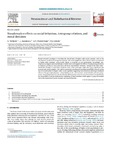NORADRENALINE EFFECTS ON SOCIAL BEHAVIOUR, INTERGROUP RELATIONS, AND MORAL DECISIONS
| dc.contributor.author | Terbeck, S | |
| dc.contributor.author | Savulescu, J | |
| dc.contributor.author | Cowen, P | |
| dc.date.accessioned | 2016-08-17T14:23:56Z | |
| dc.date.available | 2016-08-17T14:23:56Z | |
| dc.date.issued | 2016-03-04 | |
| dc.identifier.issn | 0149-7634 | |
| dc.identifier.issn | 1873-7528 | |
| dc.identifier.uri | http://hdl.handle.net/10026.1/5326 | |
| dc.description.abstract |
Recent research has begun to elucidate the neural basis of higher order social concepts, such as the mechanisms involved in intergroup relations, and moral judgments. Most theories have concentrated on higher order emotions, such as guilt, shame, or empathy, as core mechanisms. Accordingly, psychopharmacological and neurobiological studies have investigated the effects of manipulating serotonin or oxytocin activity on moral and social decisions and attitudes. However, recently it has been determined that changes in more basic emotions, such as fear and anger, might also have a significant role in social and moral cognition. This article summarizes psychopharmacological and fMRI research on the role of noradrenaline in higher order social cognition suggesting that indeed noradrenergic mediated affective changes might play key – and probably causal – role in certain social attitudes and moral judgments. Social judgments may also be directly influenced by numerous neurotransmitter manipulations but these effects could be mediated by modulation of basic emotions which appear to play an essential role in the formation of social concepts and moral behaviour. | |
| dc.format.extent | 54-60 | |
| dc.format.medium | Print-Electronic | |
| dc.language | en | |
| dc.language.iso | en | |
| dc.publisher | Elsevier BV | |
| dc.subject | Emotions | |
| dc.subject | Humans | |
| dc.subject | Interpersonal Relations | |
| dc.subject | Morals | |
| dc.subject | Norepinephrine | |
| dc.subject | Social Behavior | |
| dc.title | NORADRENALINE EFFECTS ON SOCIAL BEHAVIOUR, INTERGROUP RELATIONS, AND MORAL DECISIONS | |
| dc.type | journal-article | |
| dc.type | Article | |
| plymouth.author-url | https://www.ncbi.nlm.nih.gov/pubmed/27126289 | |
| plymouth.edition | in press | |
| plymouth.volume | 66 | |
| plymouth.publication-status | Published | |
| plymouth.journal | Neuroscience and Biobehavioural reviews | |
| dc.identifier.doi | 10.1016/j.neubiorev.2016.03.031 | |
| plymouth.organisational-group | /Plymouth | |
| plymouth.organisational-group | /Plymouth/REF 2021 Researchers by UoA | |
| plymouth.organisational-group | /Plymouth/REF 2021 Researchers by UoA/UoA04 Psychology, Psychiatry and Neuroscience | |
| dc.publisher.place | United States | |
| dcterms.dateAccepted | 2016-03-01 | |
| dc.identifier.eissn | 1873-7528 | |
| dc.rights.embargoperiod | No embargo | |
| rioxxterms.versionofrecord | 10.1016/j.neubiorev.2016.03.031 | |
| rioxxterms.licenseref.uri | http://www.rioxx.net/licenses/all-rights-reserved | |
| rioxxterms.licenseref.startdate | 2016-03-04 | |
| rioxxterms.type | Journal Article/Review |


